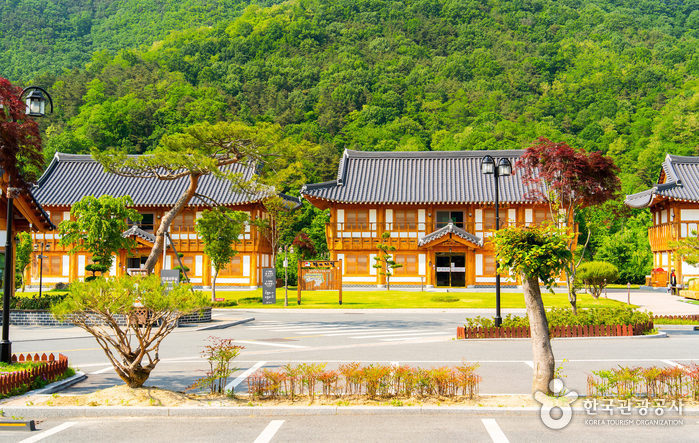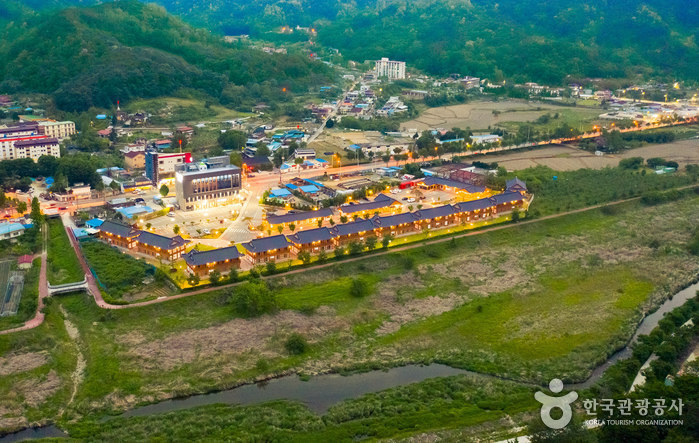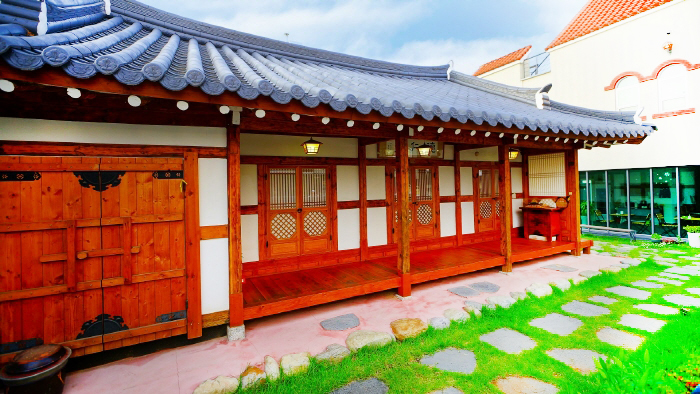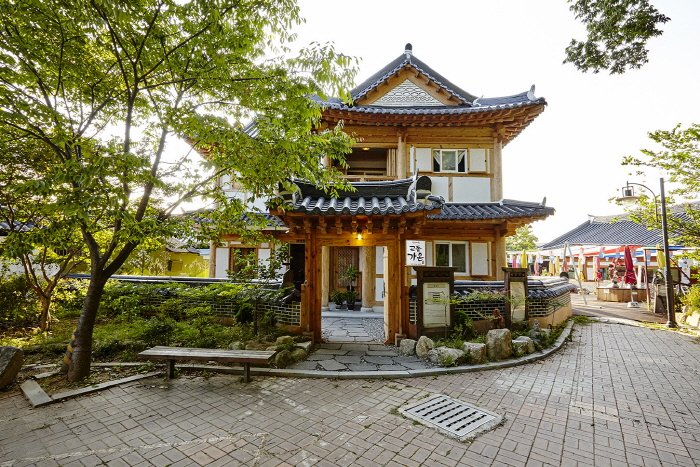Cathédrale Jeondong (전주전동성당)
9.9Km 2025-08-12
51, Taejo-ro, Wansan-gu, Jeonju-si, Région Jeonbuk
L’église catholique Jeondong de Jeonju a été érigée sur un site historique où, à l’époque de la dynastie Joseon, de nombreux catholiques furent martyrisés. Elle se situe à l’extérieur de la porte Pungnammun, dans le quartier de Jeondong à Jeonju, à l’emplacement même où des fidèles furent exécutés.
Comme Jeonju abritait le siège administratif provincial du Jeolla, Jeondong devint naturellement l’un des hauts lieux du martyre dans l’histoire du catholicisme coréen.
En 1791 (15ᵉ année du règne du roi Jeongjo), les premiers martyrs, Yun Ji-chung (Paul) et Kwon Sang-yeon (Jacques), furent exécutés ici, suivis en 1801 (1ʳᵉ année du règne du roi Sunjo) par Yu Hang-geon (Augustin), premier apôtre de la région de Honam, et Yun Ji-heon (François). Lors de la persécution de 1801, Yu Hang-geon et son frère Yu Gwan-geon furent écartelés, tandis que Yun Ji-heon, Kim Yu-san et Lee U-jip furent pendus.
Afin d’honorer leur mémoire, le père français Baudenet acheta le terrain en 1891 (28ᵉ année du règne du roi Gojong) et entreprit la construction de l’église en 1908. Elle fut achevée en 1914, sur la base des plans du père Poinel, architecte de la cathédrale Myeongdong à Séoul. Construite à l’époque de l’occupation japonaise, elle fut terminée après 23 ans de travaux.
L’édifice, en briques grises et rouges, rappelle la cathédrale Myeongdong et est considéré comme l’une des plus belles églises catholiques anciennes du pays. De style roman avec des éléments byzantins, c’est aussi l’une des plus belles réalisations architecturales de Corée. Initialement bâtie à l’extérieur de la porte Pungnammun, sur le lieu du martyre, elle fut ensuite agrandie à son emplacement actuel.
Première église de style roman construite dans la région de Honam, elle présente un plan rectangulaire et des murs extérieurs en briques, avec trois clochers byzantins – un central et deux latéraux. Le plafond intérieur est voûté en arc, et les allées latérales sont surmontées d’arcs croisés formant un motif en croix.
Certaines briques utilisées proviennent de la démolition de la forteresse de Jeonju ordonnée par le gouvernement japonais, les pierres de fondation ayant été extraites du mur d’enceinte près de la porte Pungnammun.
Sunjonggwan of the Royal Room / 왕의지밀 순종관
9.9Km 2025-08-13
5218-6, Chunhyang-ro, Wansan-gu, Jeonju-si, Région Jeonbuk
+82-63-284-1004
This hanok (traditional Korean house) hotel is located near Jeonju Hanok Village. The hotel complex stands on a plot of land spanning 19,840 m2, containing 11 residential buildings and other facilities. Modern hanok buildings are built on a line, blending with the surrounding nature to offer a comfortable stay. The name of the hotel is evident in the 11 residential buildings, all named after the kings of the Joseon Dynasty.
Sunjonggwan has six rooms in total. The rooms are divided into Gold and Silver Rooms, and are classified into Grade 2, Grade 3, and Grade 5 rooms, after the grading system used for government officials during the Joseon Period. Gold Rooms are located on the second floor, while the 1st floor is occupied by the Silver Rooms. Each room is furnished with a combination of hanok’s unique charms and modern comfort. Exposed wooden beams fill the room with a gentle scent of wood, while window walls offer an expansive view of the scenery outside.
Restaurants such as Samtaegeuk Restaurant, the site of the hotel’s breakfast offering, and Samjogo Restaurant, a Korean restaurant serving lunch and dinnertime, are designated as COVID-19 Safe Restaurants by the city of Jeonju. The Convention Center, which houses a hanok cafe, also offers a number of different facilities for the guests. It takes only 10 min by car to reach most tourist sites in Jeonju.
Porte Pungnammun (전주 풍남문)
9.9Km 2024-04-08
1, Pungnammun3(sam)-gil, Wansan-gu, Jeonju-si, Région Jeonbuk
+82-63-287-6008
La porte Pungnammun a été construite dans le milieu du royaume de Jeoson (1768) et désignée trésor national no 308. Des 4 portes originales, c’est la seule qui reste (dans la partie sud de la ville). Sa structure a été partiellement détruite lors de l’invasion des forces étrangères de 1592 à 1598. Et a été reconstruite en 1978. Jungcheung et mullu sont au centre de la porte, épousant la forme de l’arche. Ces formes particulières forment le symbole du potentiel protecteur de la porte Pungnammun tout comme ils forment le symbole de sa grandeur.
Sukjonggwan of the Royal Room/ 왕의지밀 숙종관
9.9Km 2025-08-11
5218-14, Chunhyang-ro, Wansan-gu, Jeonju-si, Région Jeonbuk
+82-63-284-1004
This hanok (traditional Korean house) hotel combines the unique aesthetics of hanok and modern comfort. Its location near Jeonju Hanok Village, the central point of Jeonju tourism, gives it excellent access to destinations in Jeonju. As evident from its name, the hotel promises a comfortable stay in a hanok since its opening in 2018. The hotel complex stands on a plot of land spanning 19,840 m2, containing 11 residential buildings that are named after the Joseon kings and other facilities.
The building Sukjonggwan contains four rooms. Each room is a self-contained unit made up of bedrooms and restrooms, furnished with a combination of hanok’s unique charms and modern comfort. Grade 1 Gold and Silver Rooms in particular have two beds and a whirlpool bathtub for the comfort of the guests. The view of the wooden exposed beams (Gold Room) speaks to the unique characteristics of hanok, while wooden pieces of furniture give the room an elegant finish. The scenery beyond the window wall is also the pride of the hotel.
The hotel has about 150 parking spots, a hanok cafe, and the Convention Center with spaces such as Daejanggeum Hall, Saimdang Hall, Chungmugong Hall, and Hunminjeongeum Hall. Samtaegeuk and Samjogo Restaurants are designated as COVID-19 Safe Restaurants by the city of Jeonju. It takes only 10 min by car to reach most tourist sites in Jeonju Hanok Village.
Jeongjogwan of the Royal Room / 왕의지밀 정조관
9.9Km 2025-08-13
5218-10, Chunhyang-ro, Wansan-gu, Jeonju-si, Région Jeonbuk
+82-63-284-1004
This hanok (traditional Korean house) hotel shows a different interpretation of hanok’s traditional beauty from Jeonju Hanok Village. The name of the hotel encapsulates Jeonju’s spirit as a city of tradition and art, and the exemplar of the state of Joseon. The hotel complex stands on a plot of land spanning 19,840 m2, containing 11 residential buildings and other facilities like hanok restaurants. Each residential building is named after the kings of the Joseon Dynasty. Jeongjogwan contains six rooms,
all built to modern comfort for all age groups. Grade 2 Silver and Gold Rooms, which can house up to 6 guests, are especially popular for families. The rooms combine modern comfort with hanok aesthetics, like wooden exposed beams and wooden furniture, which help to fill the room with the elegant fragrance of wood.
The hotel has about 150 parking spots, a hanok cafe, and the Convention Center with spaces such as Daejanggeum Hall, Saimdang Hall, Chungmugong Hall, and Hunminjeongeum Hall. Samtaegeuk and Samjogo Restaurants are designated as COVID-19 Safe Restaurants by the city of Jeonju. Jeonju Hanok Village is reachable by car in about 7 min.
Yeohangga / 여행가
10.0Km 2025-08-12
74-11, Eunhaeng-ro, Wansan-gu, Jeonju-si, Région Jeonbuk
+82-63-231-3040, +82-10-7742-6738
Yeohangga is a guesthouse owned and run by a woman who majored in early childhood education and who has been teaching children for over 20 years. The name means "A home for a happy trip," she says. It’s a unique guesthouse since the owner offers various traditional educational games. The cozy and comfortable guesthouse is a traditional Korean house built in March 2013 at a site where an old house used to be. The main building and detached building are divided by the ridge of the roof with beautiful rafters. There is another meaning to the name of the guesthouse: "a house where the woman is happy." She named it as such for a good reason. She used to live in Seoul when her parents advised her to move to Jeonju and run a guesthouse, leaving her husband and child behind. At first, she considered accepting only female guests, but it wasn't an option since most of the people visiting Jeonju are couples and groups of friends. Instead, she made sure the guesthouse is safe for women while building the house. Many female tourists traveling alone find this a great feature of the guesthouse because they feel safer during their stay. For one, she installed three doors for the rooms (1 transparent door, 1 opaque glass door, and a traditional Korean door). Not only do the guests feel safer; the rooms are also well-insulated thanks to the triple doors. The floors and walls are covered with traditional Korean paper coated with soybean oil, which is very environment-friendly. In the four rooms named “Spring,” “Summer,” “Autumn,” and “Winter,” there are many toys and materials for traditional Korean cognition games, such as “Chilgyo Game,” “Gonu Game,” and “Mabangjin.” It’s very likely that even Koreans have never heard of these games. The owner of the guesthouse chose these games specifically because they are perfect for children to play in a traditional Korean house. She teaches her little guests how to play the games. “Chilgyo Game” involves making a shape with 7 to 20 pieces, whereas “Gonu Game” is similar to the game of Chinese chess. "Mabangjin" is a type of IQ game that involves laying down a total of nine different numbers in three rows and columns so that the sum of the three numbers is identical when added horizontally, vertically, or diagonally. Many guests find these games interesting, and the owner of the guesthouse finds joy in teaching these games to as many families as possible. She recently took over another traditional Korean guesthouse called "Samrakheon" near the Jeonju Oriental Medicine Center. It's a stand-alone guesthouse for groups and families, and she uses the place to teach traditional games to more people.
Veteran Kalguksu (베테랑칼국수)
10.0Km 2025-07-10
135, Gyeonggijeon-gil, Wansan-gu, Jeonju-si, Jeonbuk
Il s’agit d’un restaurant de nouilles traditionnelles aimé des habitants de Jeonju Hanok Village depuis plus de 40 ans, ouvert en 1977. L’établissement est réputé pour son bouillon épais et onctueux, mijoté longtemps, auquel sont ajoutés du perilla (sésame sauvage), de la viande et des œufs.
Les nouilles utilisées ne sont pas les larges nouilles ordinaires, mais des nouilles fines à la texture ferme et élastique. Le plat est garni de poudre de perilla, de piment et d’algues séchées, offrant un goût et une présentation constants au fil des années.
Outre les kalguksu (nouilles coupées au couteau), le restaurant propose des nouilles froides au soja (kongguksu) au goût riche et onctueux, ainsi que des mandu (raviolis) généreusement garnis, qui accompagnent parfaitement les nouilles. Avec chaque commande, du danmuji (radis mariné jaune) et du kimchi de radis en dés (kkakdugi) sont servis ; ce dernier est préparé maison avec des radis d’hiver de Jeju, ce qui lui confère un goût encore meilleur.
◎ Informations sur la Hallyu : ce restaurant est l’un des établissements fréquentés par les acteurs du drama Vingt-cinq, vingt et un. L’actrice principale, Kim Tae-ri, y est venue pour son petit-déjeuner lors du tournage de son vlog, attirant l’attention en dégustant son bol sans en laisser une seule nouille. Tout près se trouve aussi "2521 Guesthouse", la maison d’hôte ayant servi de résidence à Hee-do dans le drama, qui vaut une visite après le repas.
Damun (다문)
10.0Km 2024-04-07
74-8, Eunhaeng-ro, Wansan-gu, Jeonju-si, Région Jeonbuk
+82-63-288-8607
Situated in Jeonju Hanok Village, Gyo-dong, Jeonju-si, Damun serves Korean table d’hote in a restaurant divided into large and small rooms within a hanok building structure.
Deokindang
10.0Km 2024-04-07
28-3, Pungnammun 3-gil, Wansan-gu, Jeonju-si, Région Jeonbuk
063-282-6336, 010-5654-3554
Deokindang is located across from the west street of Jeonju Hanok Village. The guesthouse is surrounded by low walls, inside of which there are grass yard, stone pavement, and four traditional houses with three guestrooms, which are called the Large Room, Small Room, and Kitchen Room. Here, the "Kitchen Room” is not actually a kitchen, but a kitchen turned into a bedroom. The Large Room in the center of the main building can accommodate up to 8 people, making it a perfect place to stay for a large family. It’s furnished with thin, white calico sheets, which are very soft to the touch.
Situated on the outskirts of Jeonju Hanok Village and yet very close to Gyeonggijeon Shrine, Jeondong Catholic Cathedral, Nambu Market, and Jeonju Pungpae Jigwan (Jeongju Gaeksa. Treasure No. 583), the guesthouse is quiet and conveniently located as well for those taking a tour of Jeonju. The owner of Deokindang also owns another guesthouse called Su House, so the guests of Deokindang can have access to the Community Room of Su House.
Gyodonggaon / 교동가온
10.0Km 2025-08-12
73-1, Eunhaeng-ro, Wansan-gu, Jeonju-si, Région Jeonbuk
+82-10-5106-3355
Gyodong Gaon is located right in the middle of the main street of Jeonju Hanok Village. The word "gaon" means "middle" in Korean. It's a two-story traditional Korean house that stands out among the rest of the traditional Korean houses in the alley leading to Omokdae. Just inside the gate is a yard with colorful flower trees, jars of sauces, and furnace. The mural on one of the walls is popular among the guests as a place to take photos.
The "numaru", or "loft" in Korean, overlooks the Hanok Village, and is one of the best places in the village to get a closer look at the 500 year old zelkova tree and the foot of the mountain nearby. Open to all the guests, the "numaru" is very popular during the winter as well as the summer. It's an open space with a wooden floor, so it's very cool during the summer, and it also serves as an observatory to enjoy the view of all the snow-covered trees and roofs in the Hanok Village during the winter while having a hot cup of tea.
The owner of the guesthouse has been living here for 37 years. He rebuilt his house and turned it into a hanok guesthouse in 2014 while making sure the rooms are well insulated and comfortable to stay.
He built a two-story building to make an efficient use of the space, and focused on making all the rooms look different. The house has five rooms, and only the “Meomulda Room” on the first floor is the only rooms with a living room separated from the bedroom. All you have to do is open the door to enjoy the view of the yard, Hanok Village, and Omokdae. The “Nanuda Room” on the second floor is the largest one that can accommodate more than five people, making it the most popular choice among families. The "Damda Room" and "Kkumkkuda Room" both have an attic that can be reached by a ladder. The attic is big enough to sleep two adults, and some guests actually sleep there for a unique experience. One of the walls of the attic is finished with cypress wood which has a pleasant scent. The “Geurida Room” has the best view through the two windows on the either side of the room, in addition to warm sunlight and cool wind that come through the window. Modern, not traditional, doors are installed in all the rooms for better sound proofing and insulation.
Gyodong Gaon offers a number of experience programs, such as traditional games like “gulleongsoe”, “tuho", and “Korean top”, As well as “sabang chigi”, “sampalseon”, and “ttangttameokgi”.
Many Korean adults are familiar with these games, while children and foreigners can find these games interesting. All these traditional Korean games are free to play.










 Français
Français
 한국어
한국어 English
English 日本語
日本語 中文(简体)
中文(简体) Deutsch
Deutsch Español
Español Русский
Русский